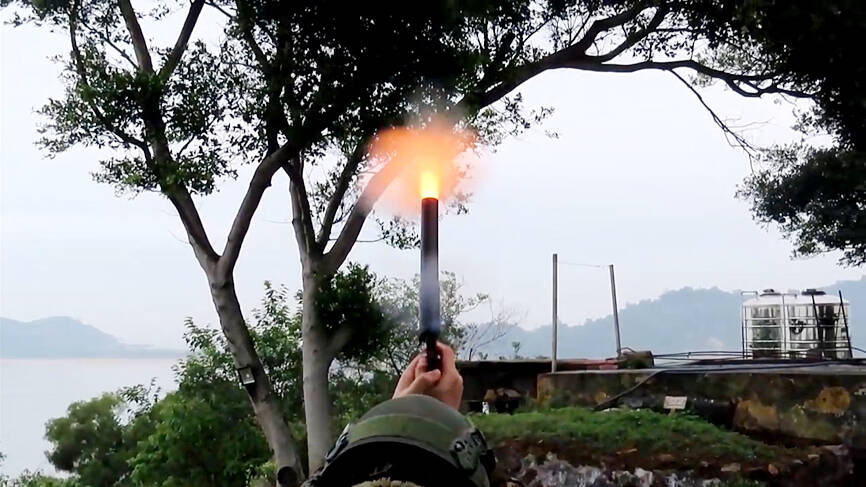The US on Monday urged restraint and no unilateral change to the “status quo” across the Taiwan Strait amid China’s “gray zone” harassment of Taiwan, including the use of drones near Kinmen County.
Earlier on Monday, Kinmen Defense Command said that subordinate units detected a civilian drone approaching the islands of Erdan (二膽) and then Menghu (猛虎) at about 9am and 2pm respectively.
The movements came after a Chinese YouTube channel posted drone videos of Taiwan’s military supplies and transportation on Erdan on March 30.

Photo courtesy of Kinmen Defense Command
Often seen as a front line in any potential hostilities between China and Taiwan, the Kinmen islands lie just off the southeastern coast of China, with Erdan and Menghu just 5km to 6km away from the Chinese city of Xiamen.
Asked to comment on China’s “gray zone” tactics against Taiwan, a spokesman for the US Department of State told the Central News Agency that Washington is closely monitoring Beijing’s actions.
“We continue to urge restraint and no unilateral change to the status quo, which has preserved peace and stability in the Taiwan Strait and throughout the region for decades,” the spokesman said. “We urge the PRC [People’s Republic of China] to engage in meaningful dialogue with Taiwan to reduce the risk of miscalculation.”
“The United States shares with other countries an abiding interest in peace and stability across the Taiwan Strait and in the broader Indo-Pacific region, which impact global security and prosperity,” the spokesman said.
Army Chief of Staff Lieutenant General Chen Chien-yi (陳建義) on Wednesday last week said that Chinese filming of the islands of Dadan and Erdan is part of its “gray zone” tactics against Taiwan, which are aimed at undermining the morale of the Taiwanese military.
The drone flights were not unexpected, and they have happened in the past and will happen again in the future, he said.
Thomas Shattuck, a US academic specializing in cross-strait relations, said at an online seminar late last month that Taiwan, with limited resources, should learn from the Philippines.
The Philippines has had many confrontations with China in the South China Sea, and has tried to counter its intrusions by recording Beijing’s military harassment and publicizing it to try to galvanize public outrage in the international community, he said.

Chinese Nationalist Party (KMT) Chairman Eric Chu (朱立倫), spokeswoman Yang Chih-yu (楊智伃) and Legislator Hsieh Lung-chieh (謝龍介) would be summoned by police for questioning for leading an illegal assembly on Thursday evening last week, Minister of the Interior Liu Shyh-fang (劉世芳) said today. The three KMT officials led an assembly outside the Taipei City Prosecutors’ Office, a restricted area where public assembly is not allowed, protesting the questioning of several KMT staff and searches of KMT headquarters and offices in a recall petition forgery case. Chu, Yang and Hsieh are all suspected of contravening the Assembly and Parade Act (集會遊行法) by holding

PRAISE: Japanese visitor Takashi Kubota said the Taiwanese temple architecture images showcased in the AI Art Gallery were the most impressive displays he saw Taiwan does not have an official pavilion at the World Expo in Osaka, Japan, because of its diplomatic predicament, but the government-backed Tech World pavilion is drawing interest with its unique recreations of works by Taiwanese artists. The pavilion features an artificial intelligence (AI)-based art gallery showcasing works of famous Taiwanese artists from the Japanese colonial period using innovative technologies. Among its main simulated displays are Eastern gouache paintings by Chen Chin (陳進), Lin Yu-shan (林玉山) and Kuo Hsueh-hu (郭雪湖), who were the three young Taiwanese painters selected for the East Asian Painting exhibition in 1927. Gouache is a water-based

Taiwan would welcome the return of Honduras as a diplomatic ally if its next president decides to make such a move, Minister of Foreign Affairs Lin Chia-lung (林佳龍) said yesterday. “Of course, we would welcome Honduras if they want to restore diplomatic ties with Taiwan after their elections,” Lin said at a meeting of the legislature’s Foreign Affairs and National Defense Committee, when asked to comment on statements made by two of the three Honduran presidential candidates during the presidential campaign in the Central American country. Taiwan is paying close attention to the region as a whole in the wake of a

OFF-TARGET: More than 30,000 participants were expected to take part in the Games next month, but only 6,550 foreign and 19,400 Taiwanese athletes have registered Taipei city councilors yesterday blasted the organizers of next month’s World Masters Games over sudden timetable and venue changes, which they said have caused thousands of participants to back out of the international sporting event, among other organizational issues. They also cited visa delays and political interference by China as reasons many foreign athletes are requesting refunds for the event, to be held from May 17 to 30. Jointly organized by the Taipei and New Taipei City governments, the games have been rocked by numerous controversies since preparations began in 2020. Taipei City Councilor Lin Yen-feng (林延鳳) said yesterday that new measures by